Computer Vision Observation for Progressive Failure Characteristics of a Moderately Weathered Red Mudstone Foundation: Design and Experiment
Abstract
1. Introduction
2. Test Method
2.1. Test Procedure
2.2. Geological Condition
2.3. Rock Base Load Test
2.4. Triaxial Test
2.5. Binocular Vision
3. Results
3.1. Rock Base Load Test
3.2. Triaxial Test
3.3. Binocular Vision
4. Discussion
4.1. Progressive Failure
4.2. Failure Pattern
5. Conclusions
Author Contributions
Funding
Data Availability Statement
Conflicts of Interest
References
- Dai, Z.; Guo, J.; Yu, F.; Zhou, Z.; Li, J.; Chen, S. Long-term uplift of high-speed railway subgrade caused by swelling effect of red-bed mudstone: Case study in Southwest China. Bull. Eng. Geol. Environ. 2021, 80, 4855–4869. [Google Scholar] [CrossRef]
- Zhang, S.; Xu, Q.; Hu, Z. Effects of rainwater softening on red mudstone of deep-seated landslide, Southwest China. Eng. Geol. 2016, 204, 1–13. [Google Scholar] [CrossRef]
- Zhang, C.-L.; Jiang, G.-L.; Su, L.-J.; Liu, W.-M. Dynamic behaviour of weathered red mudstone in Sichuan (China) under triaxial cyclic loading. J. Mt. Sci. 2018, 15, 1789–1906. [Google Scholar] [CrossRef]
- GB 50007-2011; Code for Foundation Design of Buildings. China Building Industry Press: Beijing, China, 2011.
- Ahmadi, S.; Kamalian, M.; Askari, F. Evaluation of the Static Bearing Capacity Coefficients of Rough Strip Footing Using the Stress Characteristics Method. Int. J. Civ. Eng. 2021, 19, 155–165. [Google Scholar] [CrossRef]
- Cascone, E.; Casablanca, O. Static and seismic bearing capacity of shallow strip footings. Soil Dyn. Earthq. Eng. 2016, 84, 204–223. [Google Scholar] [CrossRef]
- Huang, C.-C.; Al-Aghbari, M.Y.; Mohamedzein, Y.E.-A. Ultimate bearing capacity of saturated reinforced horizontal ground. Geosynth. Int. 2016, 23, 1–8. [Google Scholar] [CrossRef]
- Shen, P.; Tang, H.; Wang, D.; Ning, Y.; Zhang, Y.; Su, X. A statistical damage constitutive model based on unified strength theory for embankment rocks. Mar. Georesour. Geotechnol. 2019, 38, 818–829. [Google Scholar] [CrossRef]
- Shen, P.; Tang, H.; Wang, D.; Su, X.; Huang, L. Weakening of mudstone fragments due to disintegration: An experimental investigation. Bull. Eng. Geol. Environ. 2020, 79, 5477–5497. [Google Scholar] [CrossRef]
- Zhang, C.; Jiang, G.; Buzzi, O.; Su, L. Full-scale model testing on the dynamic behaviour of weathered red mudstone subgrade under railway cyclic loading. Soils Found. 2019, 59, 296–315. [Google Scholar] [CrossRef]
- Bell, F. Engineering in Rock Masses; Butterworth-Heinemann: New York, NY, USA, 1994. [Google Scholar]
- Duncan, C.W. Foundations on Rock; E & FN Spon: London, UK, 1992. [Google Scholar]
- AlKhafaji, H.; Imani, M.; Fahimifar, A. Ultimate Bearing Capacity of Rock Mass Foundations Subjected to Seepage Forces Using Modified Hoek–Brown Criterion. Rock Mech. Rock Eng. 2020, 53, 251–268. [Google Scholar] [CrossRef]
- Yodsomjai, W.; Keawsawasvong, S.; Lai, V.Q. Correction to: Limit Analysis Solutions for Bearing Capacity of Ring Foundations on Rocks Using Hoek–Brown Failure Criterion. Int. J. Geosynth. Ground Eng. 2021, 7, 29. [Google Scholar] [CrossRef]
- Imani, M.; Fahimifar, A.; Sharifzadeh, M. Bearing failure modes of rock foundations with consideration of joint spacing. Sci. Iran. 2012, 19, 1411–1421. [Google Scholar] [CrossRef]
- Aydin, A.; Borja, R.I.; Eichhubl, P. Geological and mathematical framework for failure modes in granular rock. J. Struct. Geol. 2006, 28, 83–98. [Google Scholar] [CrossRef]
- Zhang, L.; Li, B.; Zhu, B.; Luo, B. Study on loading and unloading mechanical properties and energy evolution mechanism of red-bed mudstone. J. Southwest Jiaotong Univ. 2021, 40, 1000–1007. [Google Scholar]
- Wang, Z.; Wang, J.; Yang, S.; Li, L.; Li, M. Failure behaviour and acoustic emission characteristics of different rocks under uniaxial compression. J. Geophys. Eng. 2020, 17, 76–88. [Google Scholar] [CrossRef]
- Marek, L.; Miřijovský, J.; Tuček, P. Monitoring of the shallow landslide using UAV photogrammetry and geodetic measurements. In Engineering Geology for Society and Territory; Springer: Berlin/Heidelberg, Germany, 2015; Volume 2, pp. 113–116. [Google Scholar]
- Benoit, L.; Briole, P.; Martin, O.; Thom, C.; Malet, J.-P.; Ulrich, P. Monitoring landslide displacements with the Geocube wireless network of low-cost GPS. Eng. Geol. 2015, 195, 111–121. [Google Scholar] [CrossRef]
- Woo, K.-S.; Eberhardt, E.; Rabus, B.; Stead, D.; Vyazmensky, A. Integration of field characterisation, mine production and InSAR monitoring data to constrain and calibrate 3-D numerical modelling of block caving-induced subsidence. Int. J. Rock Mech. Min. Sci. 2012, 53, 166–178. [Google Scholar] [CrossRef]
- Tang, H.; Ge, Y.; Wang, L.; Yuan, Y.; Huang, L.; Sun, M. Study on estimation method of rock mass discontinuity shear strength based on three-dimensional laser scanning and image technique. J. Earth Sci. 2012, 23, 908–913. [Google Scholar] [CrossRef]
- Liu, C.; Liu, X.; Peng, X.; Wang, E.; Wang, S. Application of 3D-DDA integrated with unmanned aerial vehicle–laser scanner (UAV-LS) photogrammetry for stability analysis of a blocky rock mass slope. Landslides 2019, 16, 1645–1661. [Google Scholar] [CrossRef]
- Ohnishi, Y.; Nishiyama, S.; Yano, T.; Matsuyama, H.; Amano, K. A study of the application of digital photogrammetry to slope monitoring systems. Int. J. Rock Mech. Min. Sci. 2006, 43, 756–7666. [Google Scholar] [CrossRef]
- Hastaoğlu, K.Ö.; Gül, Y.; Poyraz, F.; Kara, B.C. Monitoring 3D areal displacements by a new methodology and software using UAV photogrammetry. Int. J. Appl. Earth Obs. Geoinf. 2019, 83, 101916. [Google Scholar] [CrossRef]
- Wang, W.; Song, H.; Zhang, Z.; Cui, H. Landslide Multi-attitude Data Measurement of Bedding Rock Slope Model. Int. J. Parallel Program. 2019, 48, 928–939. [Google Scholar] [CrossRef]
- Yang, L.; Wang, B.; Zhang, R.; Zhou, H.; Wang, R. Analysis on Location Accuracy for the Binocular Stereo Vision System. IEEE Photonics J. 2018, 10, 7800316. [Google Scholar] [CrossRef]
- Zhao, S.; Kang, F.; Li, J. Displacement monitoring for slope stability evaluation based on binocular vision systems. Optik 2018, 171, 658–671. [Google Scholar] [CrossRef]
- Zhao, P.; Wang, N.-H. Precise perimeter measurement for 3D object with a binocular stereo vision measurement system. Optik 2010, 121, 953–957. [Google Scholar] [CrossRef]
- Hu, Q.; He, S.; Wang, S.; Liu, Y.; Zhang, Z.; He, L.; Wang, F.; Cai, Q.; Shi, R.; Yang, Y. A High-Speed Target-Free Vision-Based Sensor for Bus Rapid Transit Viaduct Vibration Measurements Using CMT and ORB Algorithms. Sensors 2017, 17, 1305. [Google Scholar] [CrossRef]
- Hu, Q.; Feng, Z.; He, L.; Shou, Z.; Zeng, J.; Tan, J.; Bai, Y.; Cai, Q.; Gu, Y. Accuracy improvement of binocular vision measurement system for slope deformation monitoring. Sensors 2020, 20, 1994. [Google Scholar] [CrossRef]
- Hu, Q.; Ma, C.; Bai, Y.; He, L.; Tan, J.; Cai, Q.; Zeng, J. A rapid method of the rock mass surface reconstruction for surface deformation detection at close range. Sensors 2020, 20, 5371. [Google Scholar] [CrossRef]
- He, L.; Tan, J.; Hu, Q.; He, S.; Cai, Q.; Fu, Y.; Tang, S. Non-contact measurement of the surface displacement of a slope based on a smart binocular vision system. Sensors 2018, 18, 2890. [Google Scholar] [CrossRef]
- Zhang, Z. A flexible new technique for camera calibration. IEEE Trans. Pattern Anal. Mach. Intell. 2000, 22, 1330–1334. [Google Scholar] [CrossRef]
- Kumar, P. Shear failure envelope of Hoek-Brown criterion for rockmass. Tunn. Undergr. Space Technol. 1998, 13, 453–458. [Google Scholar] [CrossRef]
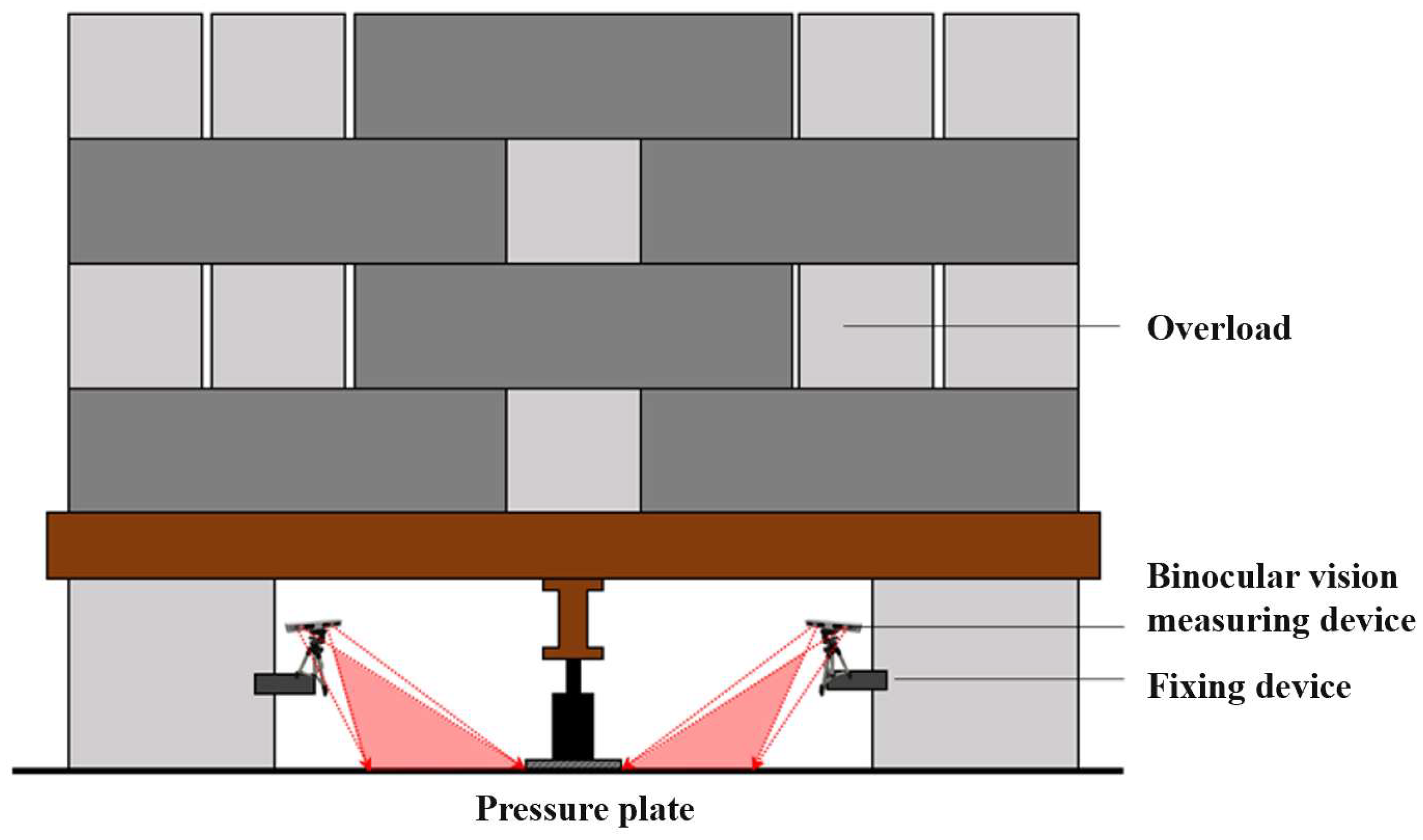
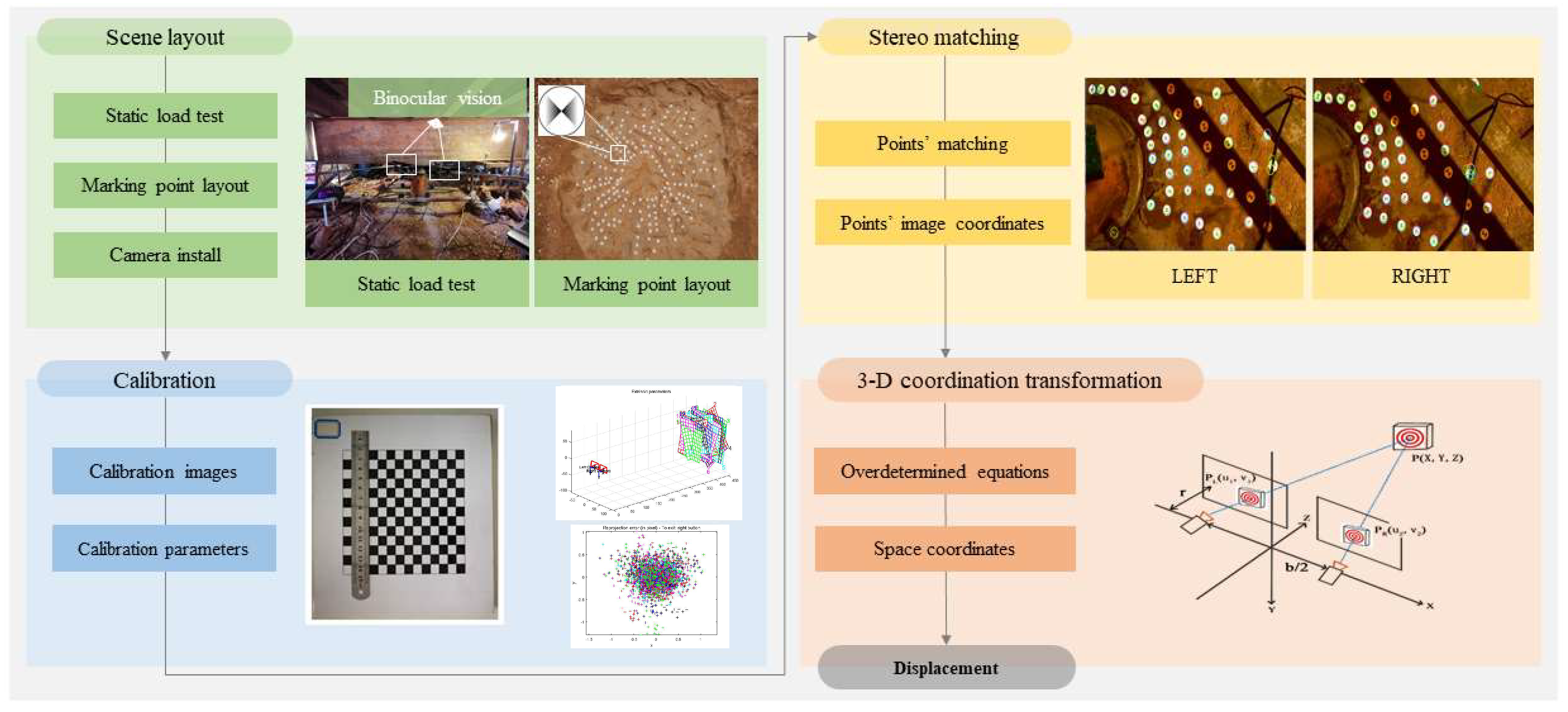
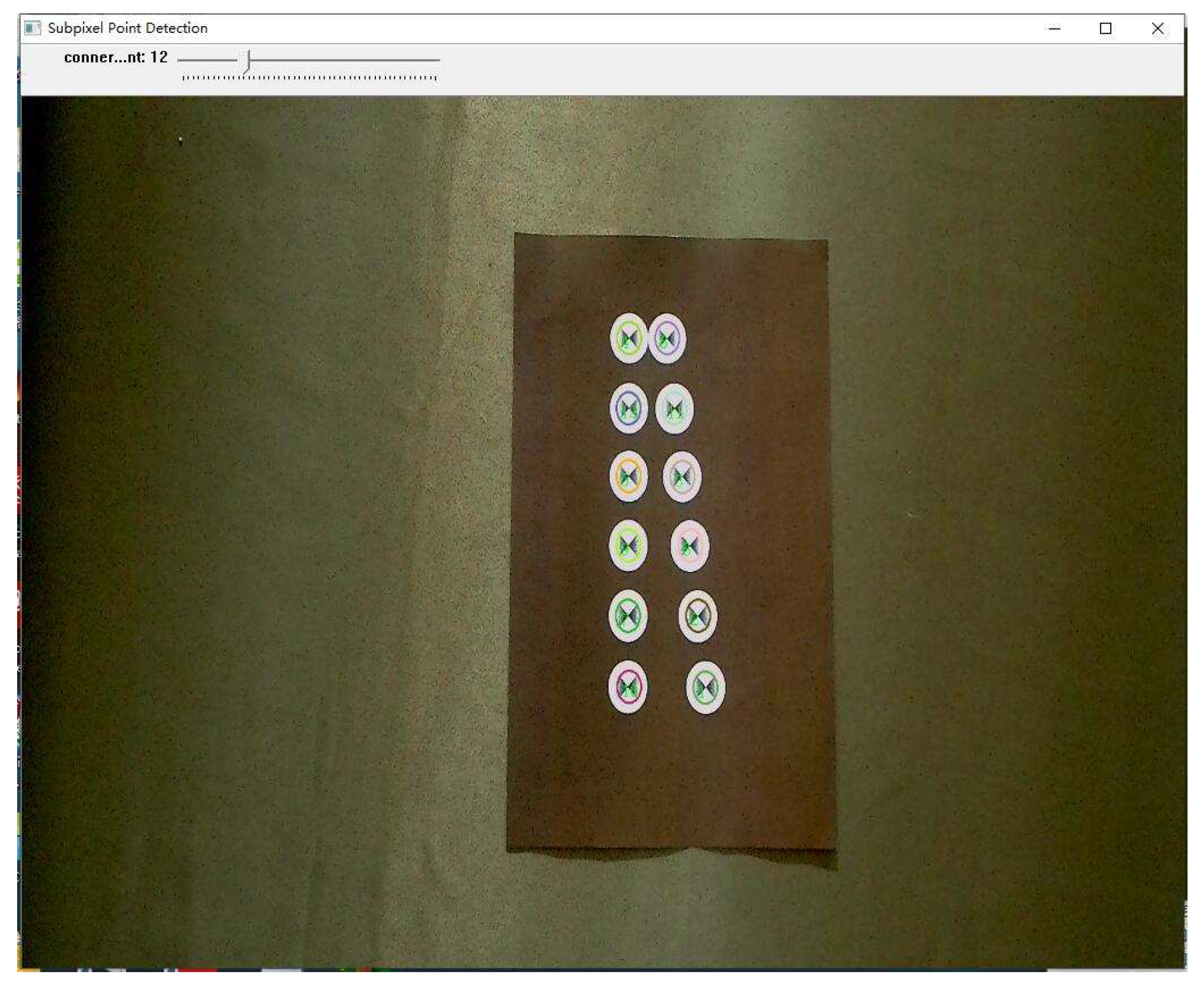

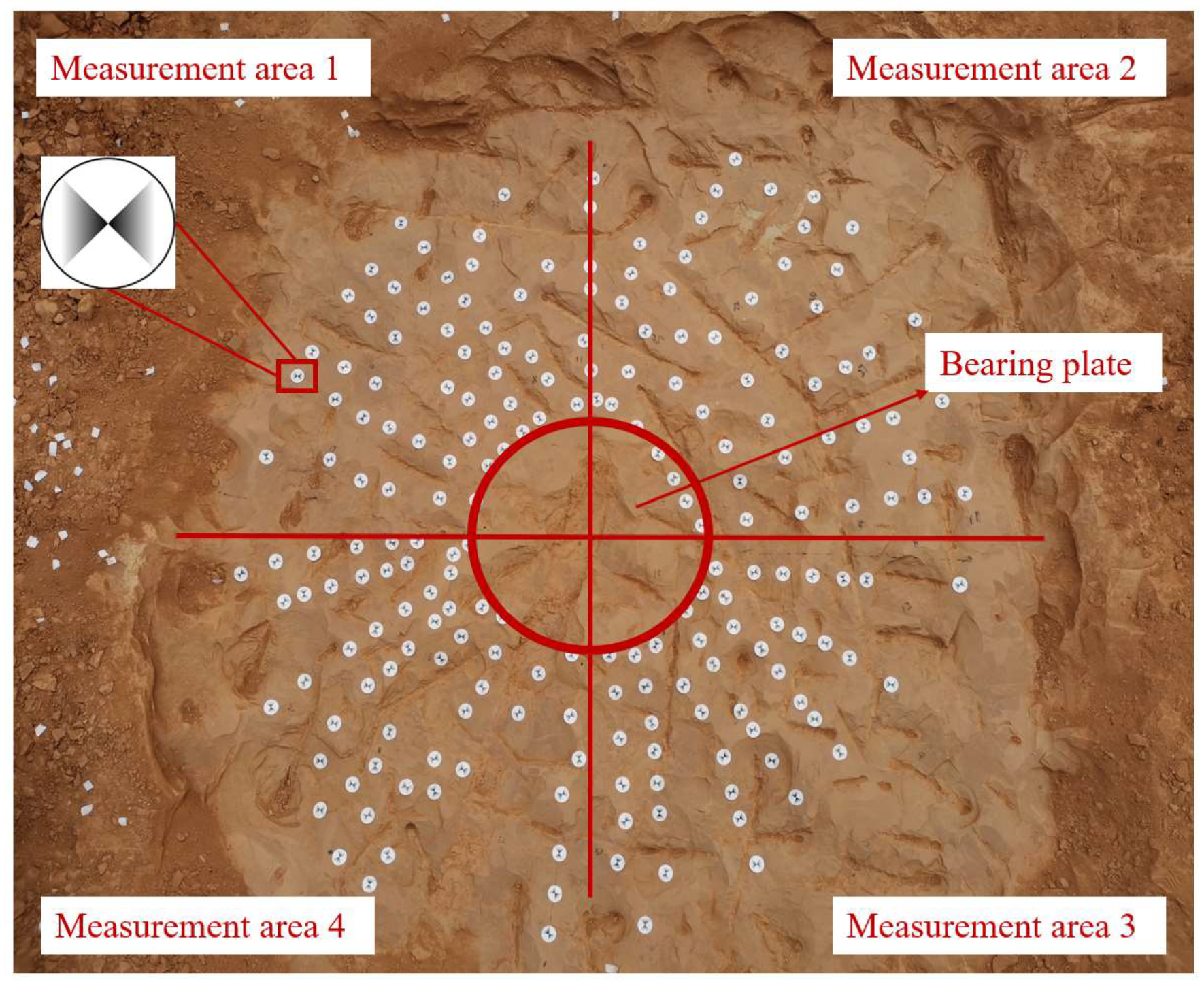
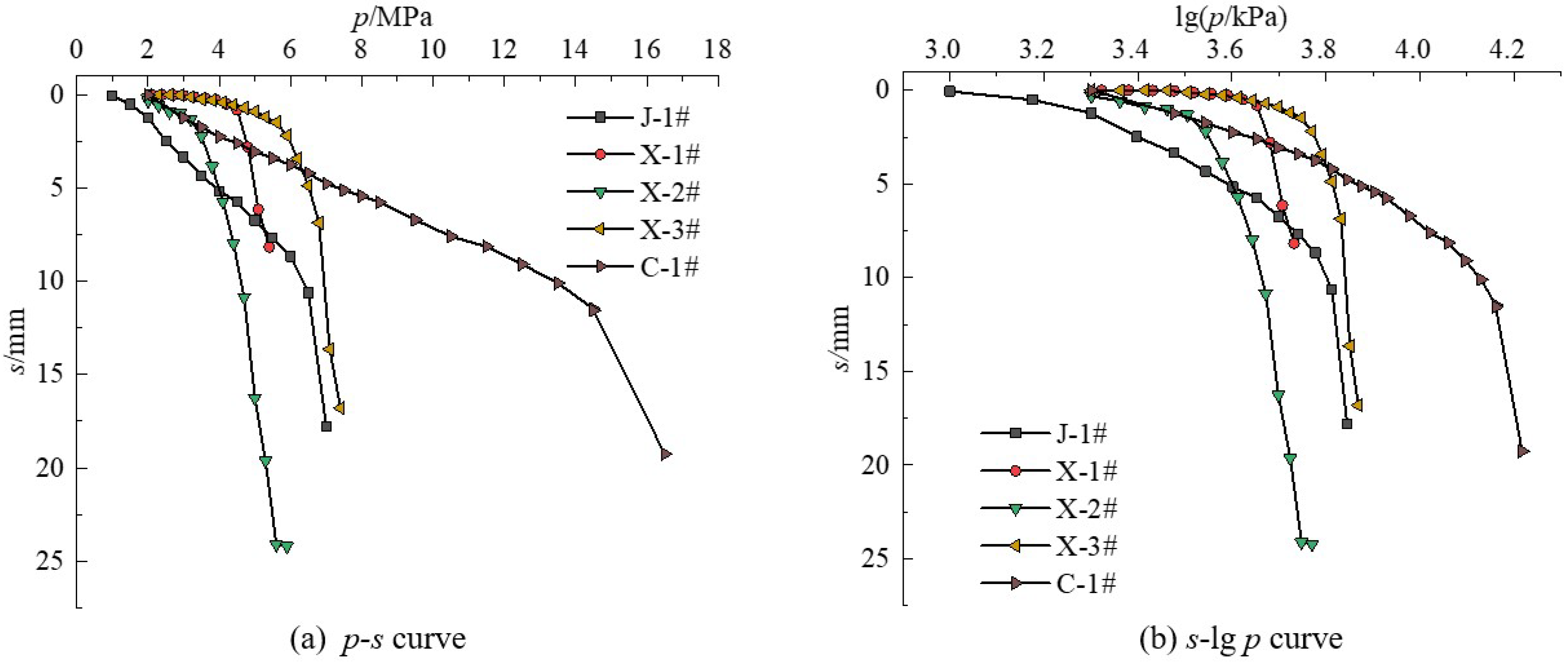


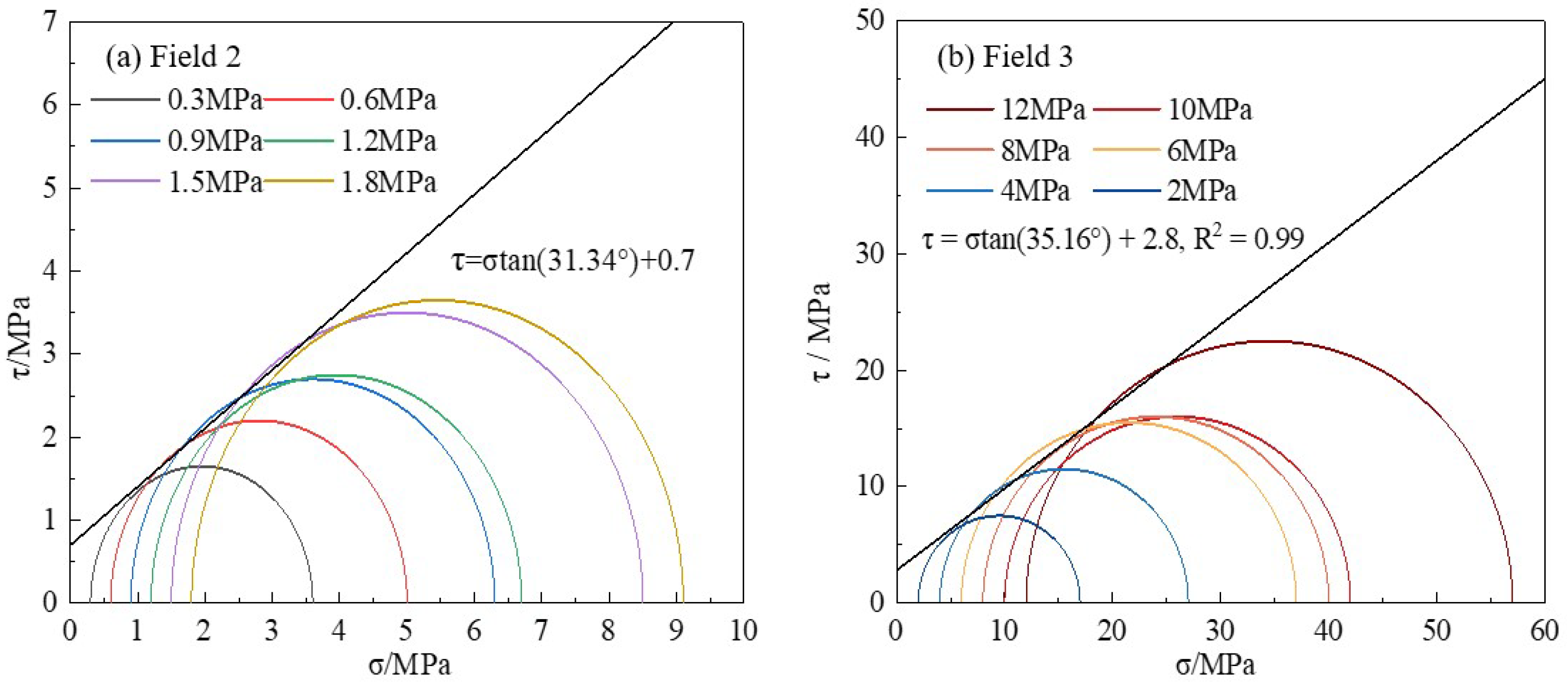
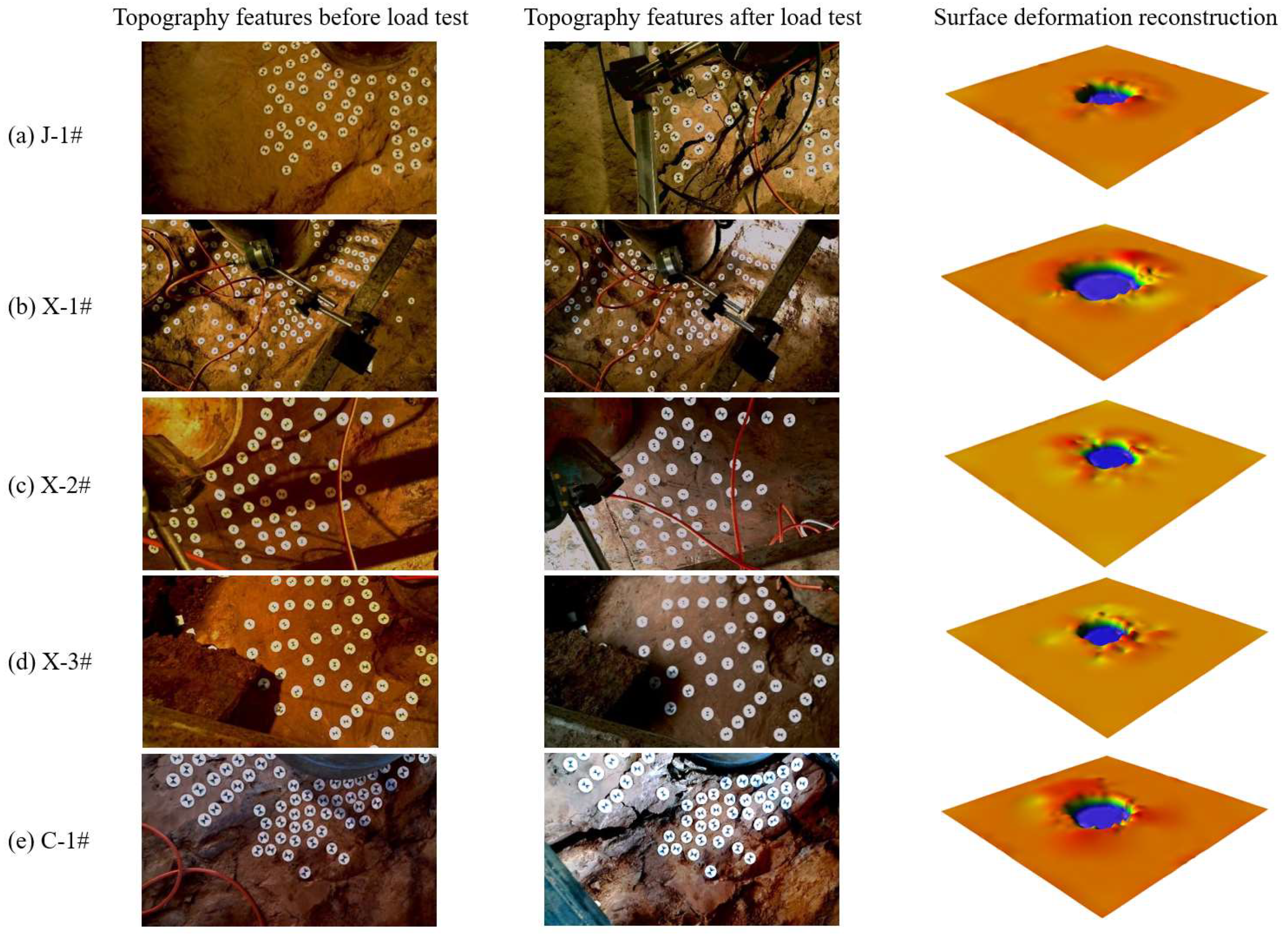
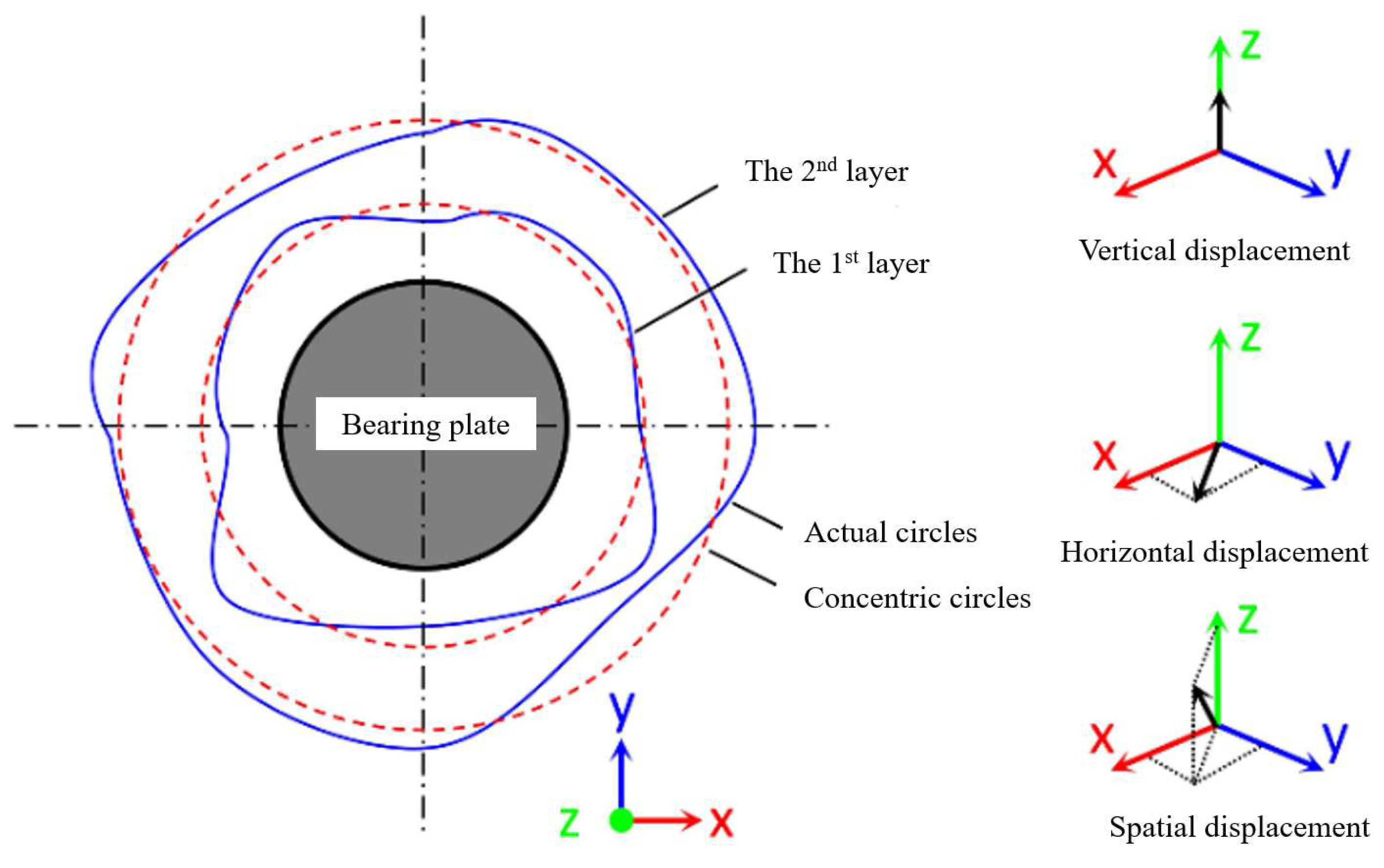
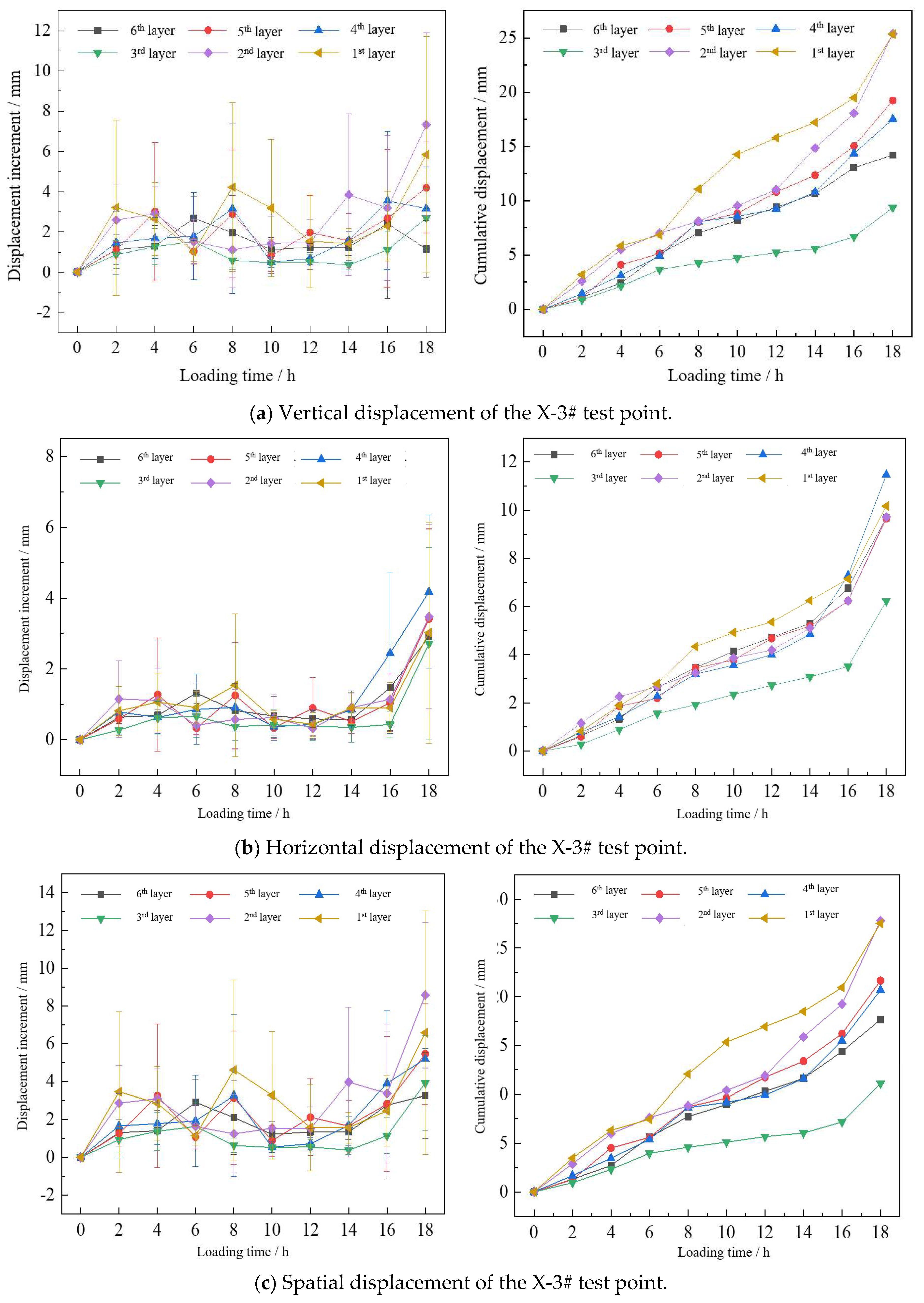
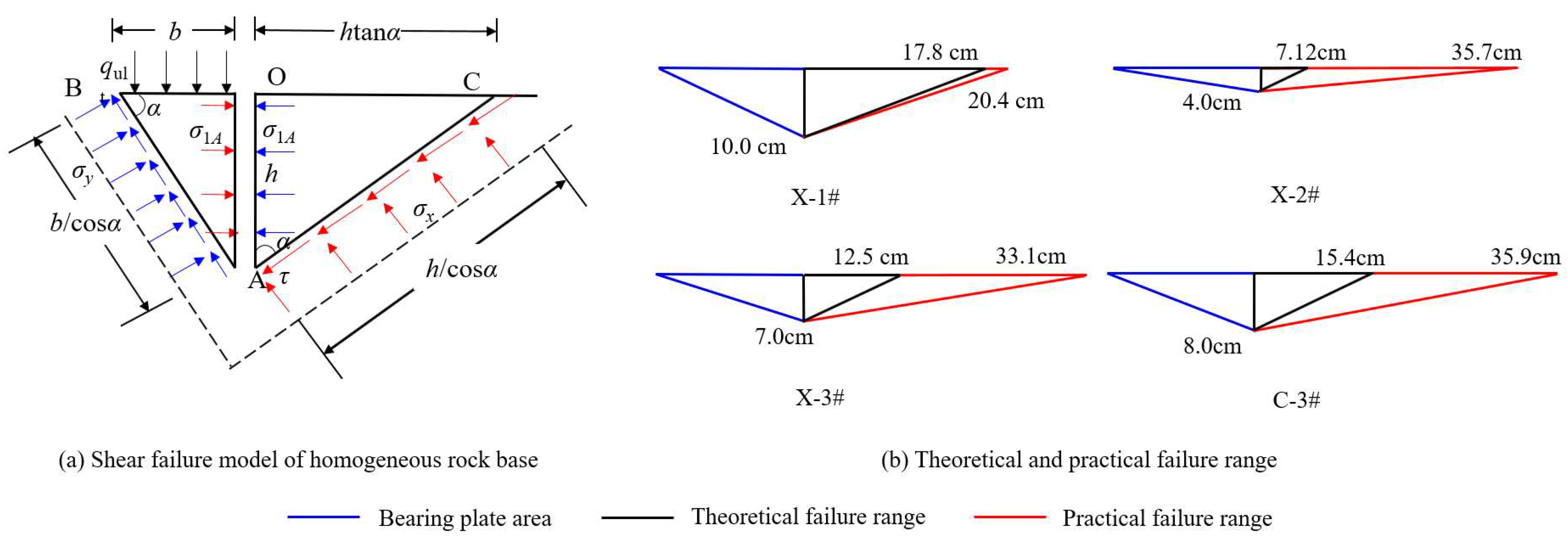
| No. | The Height Difference between the Camera and the Measuring Surface (cm) | Image Size (Pixel) | Diameter of Mark Points (mm) | Design Distance (mm) |
|---|---|---|---|---|
| 1 | 45 | 1920 × 1080 | 15 | 15, 20, 25, 30, 35, 40 |
| 2 | 20 | 20, 25, 30, 35, 40, 45 | ||
| 3 | 25 | 25, 30, 35, 40, 45, 50 | ||
| 4 | 30 | 30, 35, 40, 45, 50, 55 | ||
| 5 | 35 | 35, 40, 45, 50, 55, 60 |
| Diameters of Mark Points/d (mm) | Number of Extraction Points | Number of Effective Points | Effective Extraction Rate | |
|---|---|---|---|---|
| Left | Right | |||
| 15 | 22 | 25 | 12 | 48% |
| 20 | 16 | 18 | 12 | 66.67% |
| 25 | 12 | 12 | 12 | 100% |
| 30 | 13 | 15 | 12 | 80% |
| 35 | 12 | 12 | 12 | 100% |
| Group No. | True Value (mm) | Binocular Measurement Value (mm) | Absolute Error (mm) | Relative Error (mm) |
|---|---|---|---|---|
| 1 | 15 | 15.0688 | 0.0688 | 0.459% |
| 2 | 20 | 19.7585 | 0.2415 | 1.208% |
| 3 | 25 | 24.5706 | 0.4294 | 1.717% |
| 4 | 30 | 29.8144 | 0.1856 | 0.619% |
| 5 | 35 | 34.5277 | 0.4723 | 1.349% |
| 6 | 40 | 39.7936 | 0.2064 | 0.516% |
| Group No. | True Value (mm) | Binocular Measurement Value (mm) | Absolute Error (mm) | Relative Error (mm) |
|---|---|---|---|---|
| 1 | 20 | 19.8733 | 0.1267 | 0.634% |
| 2 | 25 | 24.5591 | 0.4409 | 1.763% |
| 3 | 30 | 29.7462 | 0.2538 | 0.846% |
| 4 | 35 | 34.3939 | 0.6061 | 1.732% |
| 5 | 40 | 39.3357 | 0.6643 | 1.661% |
| 6 | 45 | 44.1463 | 0.8537 | 1.897% |
| Group No. | True Value (mm) | Binocular Measurement Value (mm) | Absolute Error (mm) | Relative Error (mm) |
|---|---|---|---|---|
| 1 | 25 | 24.7293 | 0.2707 | 1.083% |
| 2 | 30 | 29.7088 | 0.2912 | 0.971% |
| 3 | 35 | 34.6700 | 0.3300 | 0.943% |
| 4 | 40 | 39.6047 | 0.3953 | 0.988% |
| 5 | 45 | 44.5414 | 0.4586 | 1.019% |
| 6 | 50 | 49.6011 | 0.3989 | 0.798% |
| Group No. | True Value (mm) | Binocular Measurement Value (mm) | Absolute Error (mm) | Relative Error (mm) |
|---|---|---|---|---|
| 1 | 30 | 29.7370 | 0.2630 | 0.877% |
| 2 | 35 | 34.7970 | 0.2030 | 0.580% |
| 3 | 40 | 39.5214 | 0.4786 | 1.197% |
| 4 | 45 | 44.3753 | 0.6247 | 1.388% |
| 5 | 50 | 49.4677 | 0.5323 | 1.065% |
| 6 | 55 | 54.4176 | 0.5824 | 1.059% |
| Group No. | True Value (mm) | Binocular Measurement Value (mm) | Absolute Error (mm) | Relative Error (mm) |
|---|---|---|---|---|
| 1 | 35 | 34.6730 | 0.3270 | 0.934% |
| 2 | 40 | 39.5372 | 0.4628 | 1.157% |
| 3 | 45 | 44.5003 | 0.4997 | 1.111% |
| 4 | 50 | 49.4158 | 0.5842 | 1.168% |
| 5 | 55 | 54.4826 | 0.5174 | 0.941% |
| 6 | 60 | 59.3754 | 0.6246 | 1.041% |
| Test Point | Failure Diameter of Bearing Plate/cm | Failure Depth of Bearing Plate/cm | Crack Length/cm | Crack Scope /cm2 | Breaking Condition |
|---|---|---|---|---|---|
| J-1# | 38 | 14 | 38~70 | 138 × 88 | The blocks were relatively uniform, the largest of which is . |
| X-1# | 30~35 | 10 | 20~40 | 55 × 39 | The X-1# was fragmented with the rock base at the edge of the bearing plate lifted, and part of the rock mass fell off and bulged out. |
| X-2# | 30~33 | 4 | 30~45 | - | One side of the rock mass falls off and bulges out, presenting a clastic division. |
| X-3# | 30 | 7 | 20~78 | 78 × 50 | The integrity of rock mass between fractures is good. |
| C-1# | 30 | 8 | 43~100 | 140 × 56 | The crushing area of C-1# is divided along the crushing zone. |
| Parameters | J-1# | X-1# | X-2# | X-3# | C-1# |
|---|---|---|---|---|---|
| Failure range/cm | 26.5 | 20.4 | 35.7 | 33.1 | 35.9 |
| Maximum deformation/cm | 1.1 | 2.0 | 1.1 | 1.7 | 1.8 |
| Average deformation/cm | 0.7 | 1.1 | 0.9 | 1.1 | 0.9 |
| Distance between max deformation and bearing plate/cm | 8.7 | 4.7 | 13.4 | 9.9 | 4.3 |
| No. | Stages | Load Time | Load (MPa) | The Rate of Displacement Change of a Circle of 1st Layer (mm/h) | Crack Feature | ||
|---|---|---|---|---|---|---|---|
| Vertical | Horizontal | Spatial | |||||
| OA | compaction stage | 0~6 h | 2~4 | 1.1 | 0.5 | 1.3 | / |
| AB | elastic stage | 6~8 h | 4~5 | 2.1 | 0.8 | 2.3 | / |
| BC | elastic–plastic stage | 8~12 h | 5~5.8 | 1.2 | 0.3 | 1.2 | micro fractured |
| CD | plastic stage | 12~16 h | 5.8~6.2 | 0.9 | 0.5 | 1.0 | irreversible crack |
| DE | failure stage | 16~18 h | 6.2~7.4 | 2.9 | 1.5 | 3.3 | rock broke |
| Test Points | Deformation Range/cm | Internal Friction Angle/° | Bearing Plate Failure Depth/cm | ||||||
|---|---|---|---|---|---|---|---|---|---|
| Measurement Area 1 | Measurement Area 2 | Measurement Area 3 | Measurement Area 4 | Average | Triaxial | ||||
| X-1# | 19.7 | 15.2 | 20.1 | 26.7 | 20.4 | 31.3 | 37.8 | 10.0 | 17.8 |
| X-2# | 31.9 | 34.9 | 48.5 | 27.6 | 35.7 | 31.3 | 77.2 | 4.0 | 7.1 |
| X-3# | 29.4 | 32.1 | 27.4 | 43.3 | 33.1 | 31.3 | 66.1 | 7.0 | 12.5 |
| C-1# | 37.4 | 25.6 | 39.0 | 41.7 | 35.9 | 35.1 | 64.9 | 8.0 | 15.4 |
Disclaimer/Publisher’s Note: The statements, opinions and data contained in all publications are solely those of the individual author(s) and contributor(s) and not of MDPI and/or the editor(s). MDPI and/or the editor(s) disclaim responsibility for any injury to people or property resulting from any ideas, methods, instructions or products referred to in the content. |
© 2023 by the authors. Licensee MDPI, Basel, Switzerland. This article is an open access article distributed under the terms and conditions of the Creative Commons Attribution (CC BY) license (https://creativecommons.org/licenses/by/4.0/).
Share and Cite
Bai, Y.; Hu, Q.; Feng, S.; Zheng, L.; He, L.; Wang, Y. Computer Vision Observation for Progressive Failure Characteristics of a Moderately Weathered Red Mudstone Foundation: Design and Experiment. Buildings 2023, 13, 864. https://doi.org/10.3390/buildings13040864
Bai Y, Hu Q, Feng S, Zheng L, He L, Wang Y. Computer Vision Observation for Progressive Failure Characteristics of a Moderately Weathered Red Mudstone Foundation: Design and Experiment. Buildings. 2023; 13(4):864. https://doi.org/10.3390/buildings13040864
Chicago/Turabian StyleBai, Yu, Qijun Hu, Shiqing Feng, Lining Zheng, Leping He, and Yichun Wang. 2023. "Computer Vision Observation for Progressive Failure Characteristics of a Moderately Weathered Red Mudstone Foundation: Design and Experiment" Buildings 13, no. 4: 864. https://doi.org/10.3390/buildings13040864
APA StyleBai, Y., Hu, Q., Feng, S., Zheng, L., He, L., & Wang, Y. (2023). Computer Vision Observation for Progressive Failure Characteristics of a Moderately Weathered Red Mudstone Foundation: Design and Experiment. Buildings, 13(4), 864. https://doi.org/10.3390/buildings13040864





